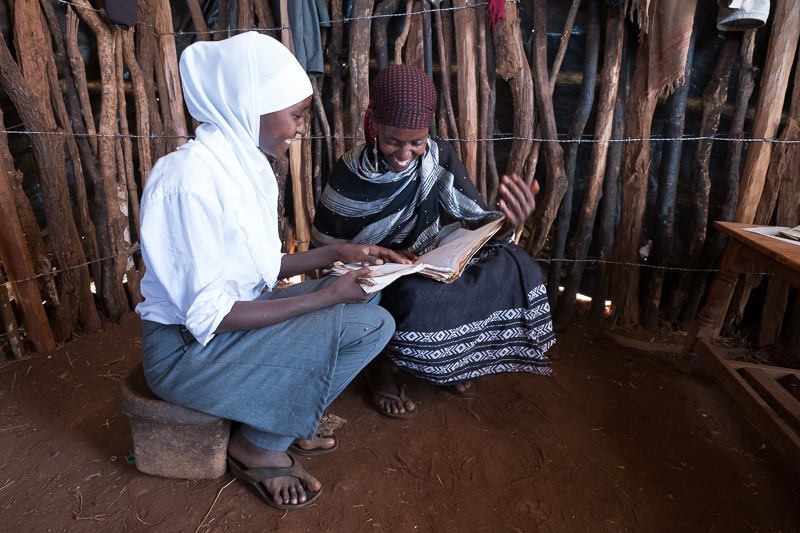
Secondary school student Jillo Guyo Ali, with her mother Kabale Galgallo Jarso, a BOMA business owner in Dhirib Gombo village, Kenya. BOMA businesses give families the resources to pay for school fees and purchase supplies. Photo: ©BOMA Project by @DavidduChemin
I am continually struck by the lives of women who are defined by their access to resources, or lack thereof, such as the women who participate in the BOMA Project’s poverty graduation program in Northern Kenya. Resources are limited in the arid lands but often it depends on how you define “resources.” Our partner, the Bill & Melinda Gates Foundation, recently came out with a position paper on gender empowerment that has helped us better define resources. As stated in A Conceptual Model of Women and Girls’ Empowerment, resources are defined as “the tangible and intangible capital and sources of power that women and girls have, own or use, individually or collectively, in the exercise of agency.”
By that definition, we can expand our understanding of the resources required for economic empowerment. Resources are not limited to water, food and land, but include education, financial tools, medical care, technology and assets. These kinds of resources expand choice and create a lasting path out of extreme poverty. Empowering women to give them access to the resources they need to build resiliency is at the heart of the BOMA Project’s mission. Our high-impact, data-driven poverty graduation program provides ultra-poor women with seed capital and financial and life skills training, enabling them to start a business and establish savings to pay for food and school fees, and obtain medical care for their families.
By focusing on women, we achieve an extraordinary return on investment for families, communities and foreign aid investors. Research reveals that women tend to invest more than 90% of their income and savings back into their families and communities, creating an upward cycle of success. In highly patriarchal societies, women’s access to financial resources and tangible assets is limited, making it difficult for them to withstand crises like drought and conflict. A successful poverty graduation program turns women who are considered resident liabilities into citizen assets, facilitating sustained access to beneficial resources such as clean water; a steady supply of food; medical care; sanitation and hygiene; technology; and inclusion in the financial institutions and structures that allow people to lift themselves out of extreme poverty.
Global randomized control trials of the poverty graduation model by research organizations like Innovations for Poverty Action have validated the global proof of concept of the poverty graduation approach as one of the most sustainable methods for building resiliency among ultra-poor populations.
The BOMA Project has adapted the traditional graduation model to the unique circumstances of the arid lands of Africa - 40% of the African continent. Our unique adaptation includes a deliberate sequencing of interventions with a group-based approach that allows women to run the business continuously. Most importantly, it includes a defined exit strategy and graduation criteria thresholds that we know can break the generational cycle of extreme poverty, creating a sustainable pathway to increased household resilience.

Our model works. In a comprehensive 2016 exit survey, after two years in our program, 94% of women graduated out of extreme poverty; 98% of participants had savings with an average increase of over 1600%; there was a 167% increase in livestock ownership and most importantly, there was an 81% decrease in the number of children going to bed without an evening meal.
The Gates paper defines assets as “Women and girls’ control over tangible or intangible economic, social or productive resources that include (1) financial and productive assets, (2) knowledge and skills, (3) time and (4) social capital.”
As BOMA participants’ financial stability increased, their access to these defined assets grew: they realized more decision-making power and autonomy; achieved ownership of tangible assets, such as business inventory and livestock; and they were able to travel and expand the inventories of their businesses by accessing new markets. They then paid it forward by helping other women in their communities learn how to access these new resources as well.
“Nowadays we also have something that belongs to us. Before, it was only the husband who had authority over everything and we didn't have anything. Now the husband knows that we have something that we own and they also respect us on that.”
-Ngurunit, a BOMA business owner
Expanding choice and agency for women and girls is not only transformative for them, but also for their families and communities, making them healthier, more stable, and more resilient. That’s empowerment. And that’s a resource that benefits our entire global community.
For more information about the BOMA Project’s work, visit www.bomaproject.org


